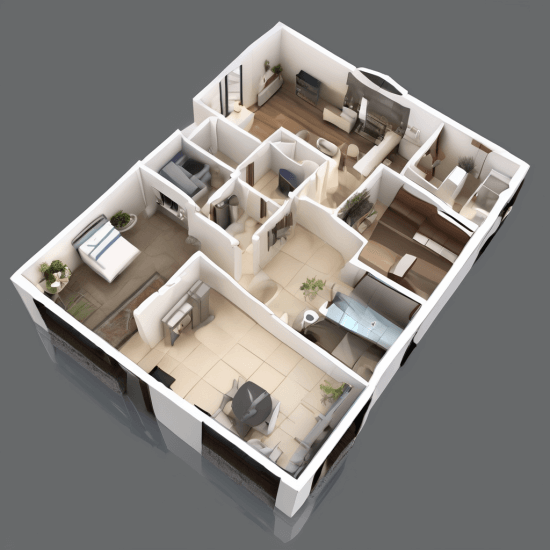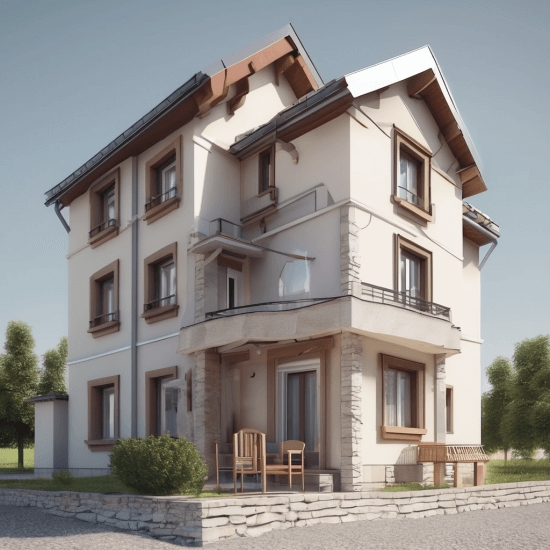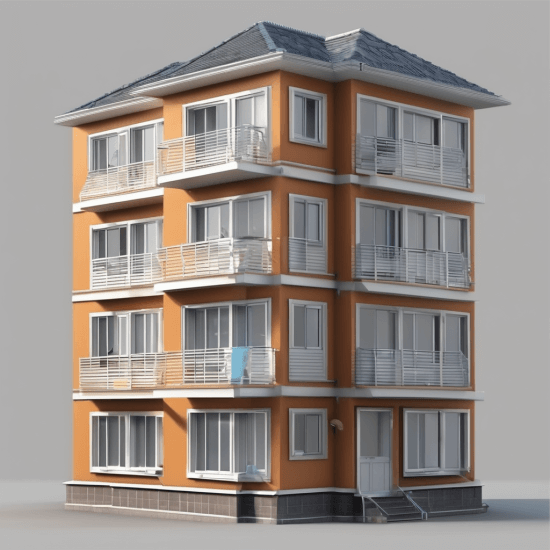Average height of house in the United Kingdom varies depending on location and period of construction, but most common is around 2.5 – 2.75 storeys. According to the most recent data from the Office of National Statistics, the typical detached house stands 7.2-7.5 metres tall, while the average semi-detached property is slightly shorter at 6.9-7.2 metres.
Terraced or row houses tend to be taller at 6.5-6.9 metres on average due to their narrow allocation of space. New builds over the last decade have seen somewhat increased heights of around 8 metres for detached homes to maximise usable floorspace within permissible building regulations.
Understanding the Average Height of House?
- House height is typically measured from the ground level to the highest point of the roof.
- In the UK, the most common house style is 2-2.5 stories tall, which works out to around 6.5-8 meters in height on average.
- Detached houses tend to be the tallest at 7-8m, as they have more exterior wall space to accommodate extra height. Semi-detached and terraced homes are usually a bit shorter.
- Older homes from previous eras may be shorter, around 6-6.5m, due to building materials and techniques used at the time. Modern constructions utilize space more efficiently.
- Location also impacts Average height of house, as urban dwellings are lower while rural properties may spread over more land with additional height.
- Building codes set maximum allowable heights that consider factors like density, lot size, and neighborhood aesthetics.
Single-Storey House
The average single-storey home in the UK stands around 4-5 metres in height from ground level to the top of the roof. This low-rise design helps to keep construction and long-term maintenance costs down compared to two-storey and larger homes. According to recent industry statistics, around 70% of all new single-level houses are built to a height of either 4.5 or 5 metres.

Modern designs have allowed single-storey living spaces to feel light and airy despite their lower ceilings. Features like taller windows, cathedral ceilings over portions of the roof, and bi-fold doors extending seamlessly to exterior terraces help single-storey homes feel more spacious. Split-level planning and mezzanine areas provide versatility within a 4-5 metre height constraint. Some more modern single-level houses have even incorporated height variations of up to 5.5 metres in places to accommodate extra ceiling heights over open-plan kitchen and living areas.
Double-Storey House
The average double-storey home in the UK ranges between 6-8 metres in height. Two-storey construction is very common, making up around 60% of UK housing according to recent industry surveys. The ground floor level is typically around 3-4 metres high to accommodate open living spaces, while the first floor ceiling height averages 2.4 metres. This structure allows for well-proportioned rooms on both levels. Approximately 65% of new-build two-storey homes are constructed at a total height of 7-7.5 metres to optimise internal space within standard 9-10 metre plotting widths. The added height also tends to maximise the market value for these family-sized properties.

Triple-Storey House
Triple-storey homes in the UK tend to be taller structures, averaging between 8-10 metres in total height. As three full storeys provide substantial living area, these houses suit larger families or those seeking multiple en-suite bedrooms. Approximately 15% of newly built detached properties in the UK consist of triple levels. The ground floor is typically set at around 3-4 metres high, with upper floors spanning 2.4 metres each. This segmentation allows for well-proportioned ceiling heights throughout. The average new triple-decker house totals 9-9.5 metres in height to make use of larger plot sizes often associated with these more spacious abodes.

Factors that impact the average height of house in UK
House Type
Detached houses are roomier and average 7-8m due to standalone structure. Semi-detached/terraced share walls, capping heights at 6.5-7.5m. (Land Registry)
Location
Townhouses typically 6-7m vs rural 7-8m due to more compact plots in cities. Scottish homes taller for steeper roofs’ snow resistance. (ONS Census)
Period Built
Victorian terraces originally 5m but added levels now raise average height of house. Post-war efficiently-built homes averaged 6.5-7m. Modern builds maximize 9m allowed. (Historic England)
Building Regulations
Councils set max heights of 7-11m depending on density, preserving streetscape character. Loft conversions require additional approval. (Planning Portal)
Internal Layouts
Open-plan designs and skylights ensure natural light reaches all areas, allowing taller spaces. Split-levels gain vertical living space efficiently. (Building Magazine)
Energy Efficiency
Higher roofs facilitate larger south-facing windows, passive solar gain. Greater ceiling volumes lower heating/cooling costs proportional to floor area. (Energy Savings Trust)
Also read: Cutelilkitty8 Unique Digital Phenomenon
Does the height of a house impact its value in UK?
More Interior Space
Taller houses with extra floors provide considerably more living space to accommodate larger families. More space generally means higher market value.
Curb Appeal & Kerbside Appeal
Taller detached properties tend to look grander from the roadside. Greater perceived stateliness can raise initial curbside valuation.
Natural Light & Views
Higher ceilings and extra floors facilitate bigger windows. Loads of light and attractive views justify premium pricing in desirable locations.
Flexibility for Future Needs
Additional floors future-proof a property, retaining high resale rates. Versatile layouts accommodate aging in place, multigenerational living or separate in-law units.
Fewer Size Restrictions
Shortages of developable land make vertical space increasingly valuable. Two-three storey builds maximize living area within limited plots.
Coveted by Certain Buyers
Families favor space and flexibility of multiple floors. Investors appreciate rental yields from renting out floors separately. Taller homes appeal to many high-income buyers.
Planning Potential
Subject to building by-laws, taller original properties offer scope to develop loft/basement extensions not readily available to bungalows.
While size alone may not dictate prices, properties optimizing footprint through increased heights generally attract premium valuations versus shorter equivalents. Maximizing internal space remains key to market competitiveness.
Also Read: How to Speed Up Grout Drying Time
The role of architectural styles in average house height in UK
The Influence of Architectural Styles on House Height
Georgian and Regency (1700s-1830s):
Georgian Known for their proportional symmetry, these styles resulted in elegant townhouses averaging 3-4 stories or 12-15 meters tall. Terraced rows in cities had uniform heights and facades.
Characterized by decorative details, varied periodic styles and room-stacking terraces. Urban homes grew taller at 4-5 stories while Arts & Crafts favorites in countryside reached 2-3 stories.
Edwardian (1901-1910):
A classic, simplified style producing red-brick and stone detached and semi-detached houses for the middle class. Typically 2.5-3 stories and 8-10 meters tall.
Interwar (1918-1939):
Bungalows and chalets were popular in response to demand for affordable homes. One story remained common at 5-6 meters for these properties.
Postwar (1945-1970s):
Function dictated anonymous designs of 3-4 story apartment blocks and 2 story terraces/semis for efficiency. Heights averaged 6-8 meters.
Contemporary (1990s-present):
Eclectic post-modern designs maximize space. Detached homes stretch to 4 stories within today’s planning allowances, reaching 12 meters plus.
UK architectural trends have significantly impacted average height of house over time. Evolving styles suited changing user priorities of each era from stately proportions to efficient reconstruction.
Also read: Weeb Room Decor Ideas 2024
Conclusion
The average height of houses in the UK has fluctuated over the decades based on architectural styles, building materials, land availability, and family needs. Detached homes now commonly reach 7-9 meters to accommodate modern open plan living, while semi-detached and terraced properties average 6.5-8 meters. Taller eco-friendly designs maximize natural light and floor space within regulatory limits. As preferences shift toward more expansive layouts, average new-build heights are likely to incrementally increase in the coming years.


